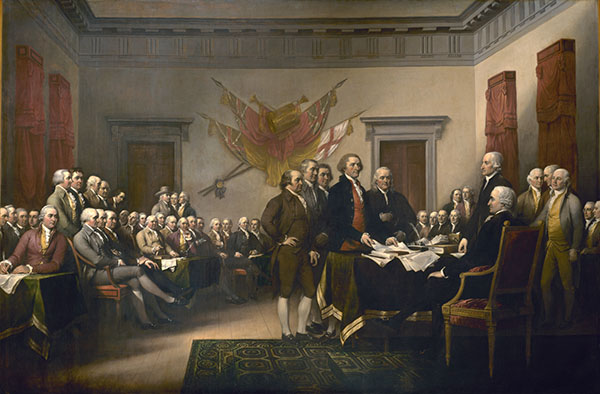The colonists’ military victory over Great Britain in 1783 did not create a new nation. Nor did the Founders ever intend it to.
When representatives of 13 of Great Britain’s colonies in North America met in Philadelphia in the summer of 1776, the resolution they adopted stated “That these United Colonies are, and of Right ought to be, Free and Independent States;” and that “as Free and Independent States, they have full Power to levy War, conclude Peace, contract Alliances, establish Commerce, and to do all other Acts and Things which Independent States may of right do.”
From United Colonies to United States
Simply declaring independence, of course, did not make the colonies independent. To do that required eight long years of war (counting from the first skirmishes in 1775 to the signing of the Treaty of Paris in 1783). The colonists’ ultimate victory in that war turned them from colonies of Great Britain into independent states. The colonies had united for the purpose of defeating a common enemy; with that accomplished, it was up to the thirteen newly independent states to decide what they would do next.
Thirteen Independent Republics
What they emphatically did not do was form a nation. No one in the former colonies imagined themselves as citizens of a single country that stretched along the Atlantic seaboard from Massachusetts to Georgia and westward to the Mississippi. Although that was the territory surrendered by Great Britain after the war, it was surrendered to the thirteen independent republics that the colonies had become. Whenever Thomas Jefferson spoke of “my country” – whether before or after the Revolution – he meant Virginia.
The Articles of Confederation
The new republics, recognizing the advantages of cooperation and friendly relations, soon formed themselves into a “firm league of friendship” or confederation – something similar to the present-day European Union. There would be agreements and treaties among the thirteen republics, but each would retain its sovereign independence. The confederation would be governed by a set of articles agreed to by all thirteen states, and all changes to these articles would require a unanimous vote. There was no strong central government; all real power was vested in the separate states.
The Articles of Confederation remained in force for barely a decade, and were then replaced by the Constitution of 1787, which did provide for a strong central government as part of a federal system of shared power with the states. Although the Constitution did finally create a single nation out of the thirteen former colonies, still, at least until the conclusion of the Civil War some eighty years later, the name of that nation, the United States of America, was considered to have a plural meaning.
Source:
- Wood, Gordon S. Empire of Liberty: A History of the Early Republic, 1789–1815. New York: Oxford University Press, 2009.








